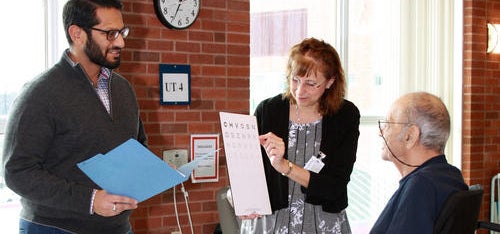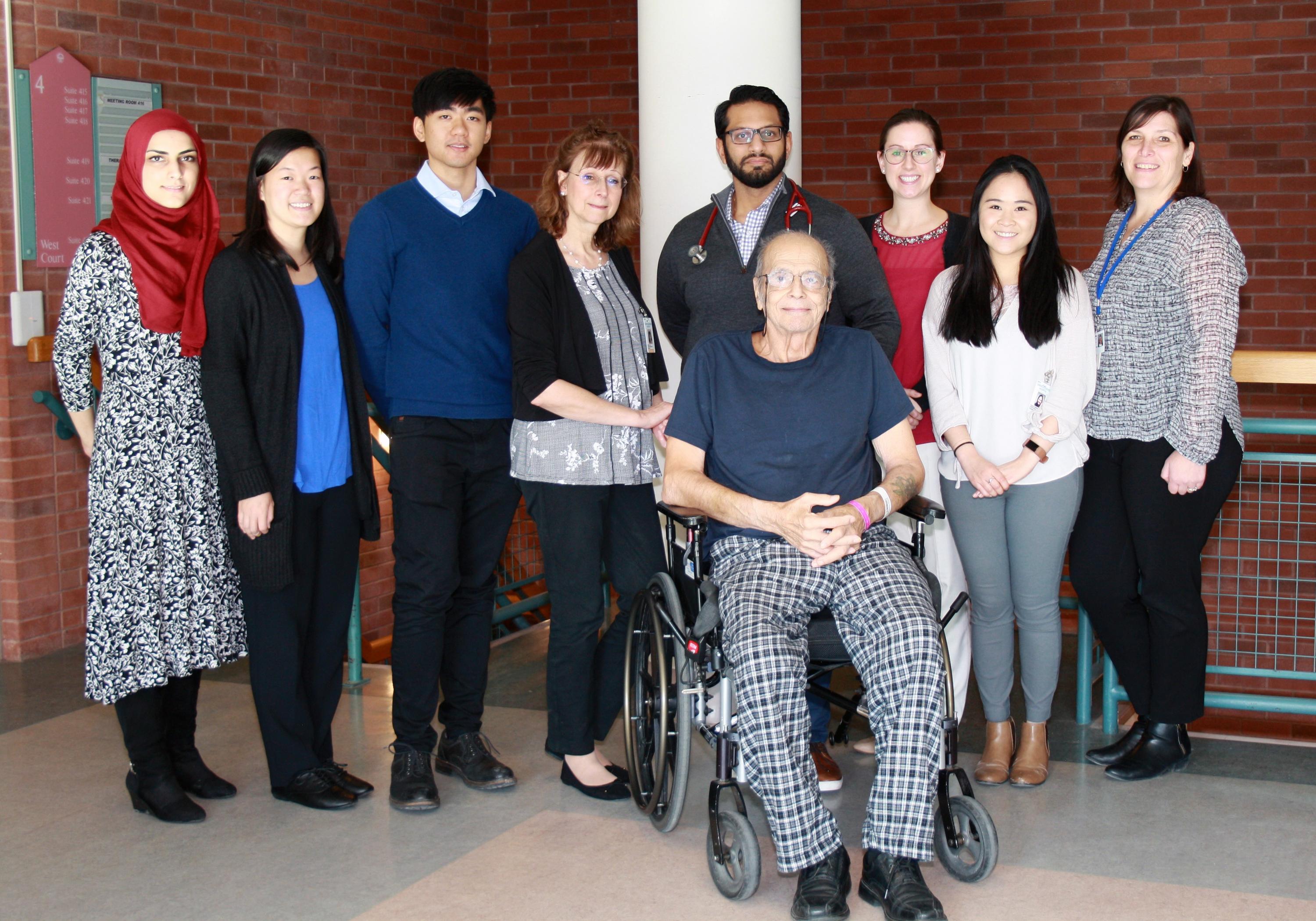
“Did you get your eyes checked?” an elderly gentleman asks a fellow patient in a hospital lunch room. When the other patient nods, he smiles.
These are two of the nearly 100 patients who are participating in a collaborative research project conducted by the University of Waterloo’s School of Optometry & Vision Science (WOVS) and Grand River Hospital (GRH), in Kitchener, Ontario. By agreeing to have their vision assessed, these patients are helping to shed light on a serious threat to seniors’ health ̶ falls.
Falls are already the leading cause of injury-related admissions for Canadian seniors. But those that occur in a hospital setting, where patients tend to be frailer and have other serious health conditions, can be deadly. In fact, one study showed that nearly half of elderly patients who break a hip while in hospital will die within a year of their fall.[i]
That’s why hospitals like GRH have developed protocols using evidence like prior falls, the use of walking aids, and balance issues to assess patients’ risk of falling while in care.
But one key element is missing in those protocols – vision.
WOVS researcher Dr. Susan Leat wants to help change that. In partnership with Dr. Abhishek Narayan of GRH, she’s conducting research to assess the visual needs of patients and how poor vision might contribute to hospital falls. She hopes to create new tools that will cut the risk of falls for older patients.
A tool to optimize care
One of Dr. Leat’s research streams focuses on vision in aging and special needs populations. A previous study she conducted at another Ontario hospital showed both a high percentage of patients with poor vision as well as an association between poor vision and falls while in hospital.[ii]
This research attracted Dr. Narayan’s attention. As Medical Director, Complex Continuing Care at GRH, he notes that ‘zero falls’ is one of the hospital’s key quality measures, “but there’s always room to optimize care.”
In the fast-paced hospital environment, where clinicians are often dealing with life-threatening conditions, there’s little time for other concerns.
"We don’t do a good job assessing vision. In fact eye drops are the most frequently missed medication on admission to hospital,” says Dr. Narayan
But what if there was an easy-to-use tool that could allow vision assessments to become a routine part of the “head-to-toe” admission screening process?
That’s one of the goals of Dr. Leat’s project.
The study is based at Grand River Hospital’s Freeport Campus, which hosts GRH’s rehabilitation program. Unlike acute care, which happens at GRH’s KW Campus, patients may stay at Freeport for several weeks, rather than days, allowing the research team time to gather information and create interventions.
“We hope to create a brief set of questions to identify patients with poor vision so that providers in the unit can take precautions to prevent falls,” Dr. Leat says.
On admission to hospital, patients will be assessed using this screening tool. Based on these results, hospital staff will be able to put safeguards in place if a patient’s score indicates they might be at increased risk of falling. Staff will also be able to give feedback to patients about their visual needs and advise them to follow up with their eye care provider once they’re released from hospital, ensuring continuity of care.
“Seeing the person in front of you”
This project is one of very few (if any) vision studies that have been conducted in a hospital setting. It’s also unique in that patient information is being gathered by optometry and vision science students, giving them hands-on clinical and research experience.
Kaitlyn Sinclair, Victoria Cadman and Nicole McKenney are three of the students who volunteered to collect data under the supervision of WOVS faculty Dr. Andre Stanberry, Dr. Tammy Labreche, Dr. Lisa Christian, Dr. Shamrozé Khan or Dr. Leat herself. One of the key reasons the students participated was the chance to see patients that they wouldn’t normally be exposed to in a primary care setting, including people recovering from stroke and other acute neurological conditions.
Working in pairs, the students interviewed patients, asking about their previous and current eye care and their general health, why they were in hospital, and if they had experienced any falls in the past. The students then conducted a series of vision function tests, including visual acuity, contrast sensitivity, stereopsis (depth perception) and visual field analysis.
In testing patients, the students sometimes witnessed the heart-breaking consequences of end-stage eye disease coupled with complicated, systemic illnesses. Patients like the woman Nicole saw who had age-related macular degeneration (AMD) that had scarred the back of her eyes.
“She demonstrated obvious eccentric viewing, turning her head to avoid looking past the scars in order to read the eye chart. Seeing this in person made me realize just how important it is to get routine exams to pick up on diseases like AMD and get them treated quickly,” Nicole says.
And while the students had the opportunity to practice their technical skills, they also gained insights into the relationship-building side of vision care. Victoria noted how many patients looked forward to their 20 minute screening and the chance to chat with the students. For Kaitlyn, working with people with cognitive or communication challenges was eye-opening.
“My partner and I were assessing a patient who had experienced a stroke and was struggling to communicate,” she says. “I could tell he was frustrated, but we listened to him, modified the tests to fit his needs and worked to make a personal connection with him. It was a much more positive experience for all of us and helped me realize that it's important to see the person in front of you, not just the condition.”
Inter-professional collaboration
The Freeport vision study is an example of inter-professional collaboration at its best, one in which all the health professionals involved ̶ physicians, nurses, optometrists and students ̶ gain a better understanding of patients and their needs.
For example, “many nurses were curious if some of their patients had visual field defects after strokes,” Victoria says. “While we weren’t able to confirm diagnosis, we could share a suspicion of restricted vision field post-stroke.”
By identifying patients’ vision problems, helping to protect them while in hospital, and connecting them to vision care providers once they’re discharged, this study may not only help to prevent falls. It could promote the goal of all health care providers: to ensure their patients lead longer, healthier lives.
A press release by Grand River Hospital is also available.
[i] Johal, K.S., Boulton, C., Moran, C.G. Hip fractures after falls in hospital: a retrospective observational cohort study. Injury, 40 (2009), pp. 201-204.
[ii] Leat, S.J., Zecevic, A, Keeling A., Hileeto D, Labreche, T., Brennan D, Brymer C, Are Falls among Hospital In-patients Linked to Vision Loss? Ophthal Physiol Opt 38 (2018): 106–114.

From left: Adeela Ahmed, Kathleen Li, Boris Wong, Dr. Susan Leat, Dr. Abhishek Narayan, patient Reginald Duguay, Nicole McKenney, Keren Delos Santos and a GRH staff member. Photo provided by Grand River Hospital.